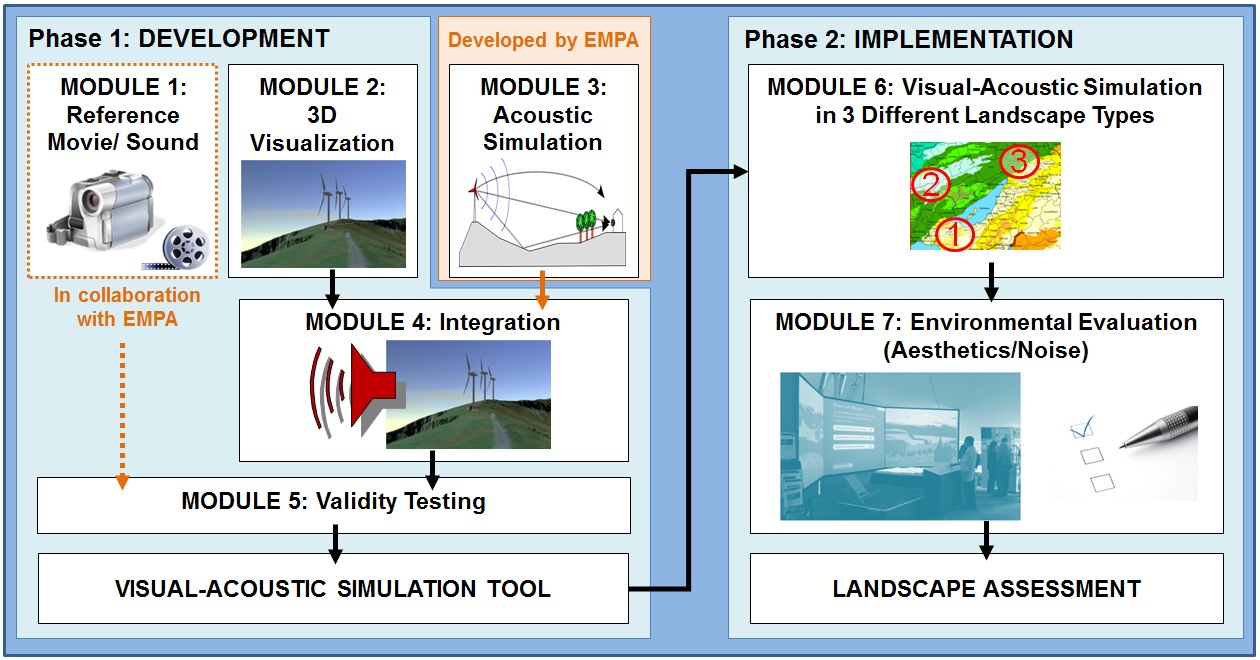The project workflow as shown in the figure below is divided into two phases:
Phase 1: development of the integrated visual-acoustic simulation model (VisAsim model)
Phase 2: Implementation of the VisAsim model for landscape assessment

Figure: Project workflow
Phase1: Development
In the first phase, a prototype of a combined visual-acoustic simulation model (VisAsim model) will be developed. This includes first the recording of reference movie and sound of the reference area (module 1), in collaboration with EMPA. Then a GIS-based 3D landscape visualization of the reference area with animated wind turbines according to the reference movie (module 2) will be generated. The corresponding acoustic simulation model of the reference area (module 3) including wind turbine emissions and natural background audio signals will be developed by EMPA.
Based on the spatially referenced parameters in the GIS-based landscape model, we will synchronize the spatially explicit sound signals and link them with the visual landscape representation (module 4). In order to test the validity, we will compare the prototype model to the real environment (module 5).
Phase 2: Implementation
In the second phase, we will implement the validated tool for assessing public preferences for wind farm options, accounting for the impacts on landscape aesthetics and noise in specific landscape contexts. We want to find out, what are the effects of the simultaneous presentation of visual and acoustic effects of wind power plants on the preferences for a wind farm scenario. Furthermore, is there a difference in the influence of the noise of wind turbines on the assessment of landscape aesthetics depending on the landscape type? To answer these questions, three focus areas with different landscape characteristics and of different landscape sensibility (module 6) will be generated, applying the prototype elaborated in phase 1. Then we will conduct a acceptability study with selected experts and lay people in a laboratory experiment (module 7). Therefore we will create simulations allowing expressing the preferences for diverse wind farm scenarios in different landscape types to determine the (mutual) effects of the integrated visual-acoustic simulation on the evaluation of landscape aesthetics and noise perception.
Interdisciplinary approach
An interdisciplinary approach is necessary because know how and techniques for acoustical auralization are required and new algorithms and strategies have to be developed for simulating spatially explicit sound of wind turbines taking into account the environmental context. To this end, the Laboratory for Acoustics at Empa has many years of experience in measuring sound emissions and calculating physically correct sound propagation with high accuracy.
Further, approaches for GIS-based 3D landscape visualization are needed in order to generate and present adequate virtual representations of the landscape for visual landscape assessment. Experienced researchers and the available equipment at PLUS/ETHZ allow for generating high quality landscape visualizations. PLUS/ETHZ also provides the required expert knowledge on the application of innovative approaches of integrating visualizations and acceptability studies into surveys for landscape valuation.
In the implementation of the research plan, close collaboration of the two disciplinary laboratories at Empa and ETHZ will take place. This comprises the collaboration in the production of the reference movie including sound recordings, the implementation and testing of the audiovisual reproduction system as well as conducting the acceptability study. The facilities of both laboratories will be used for ensuring appropriate methods of audio and video reproduction.
